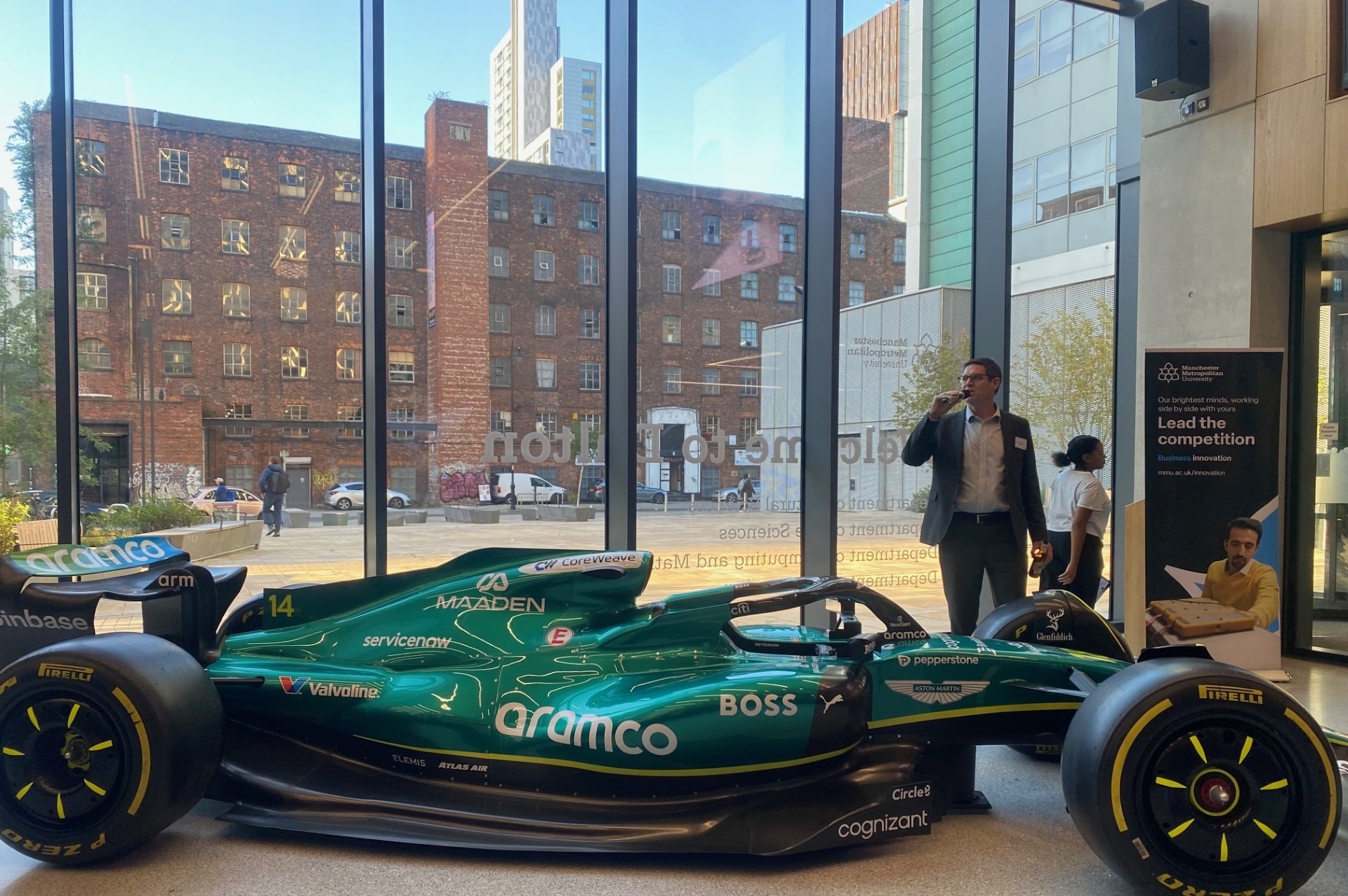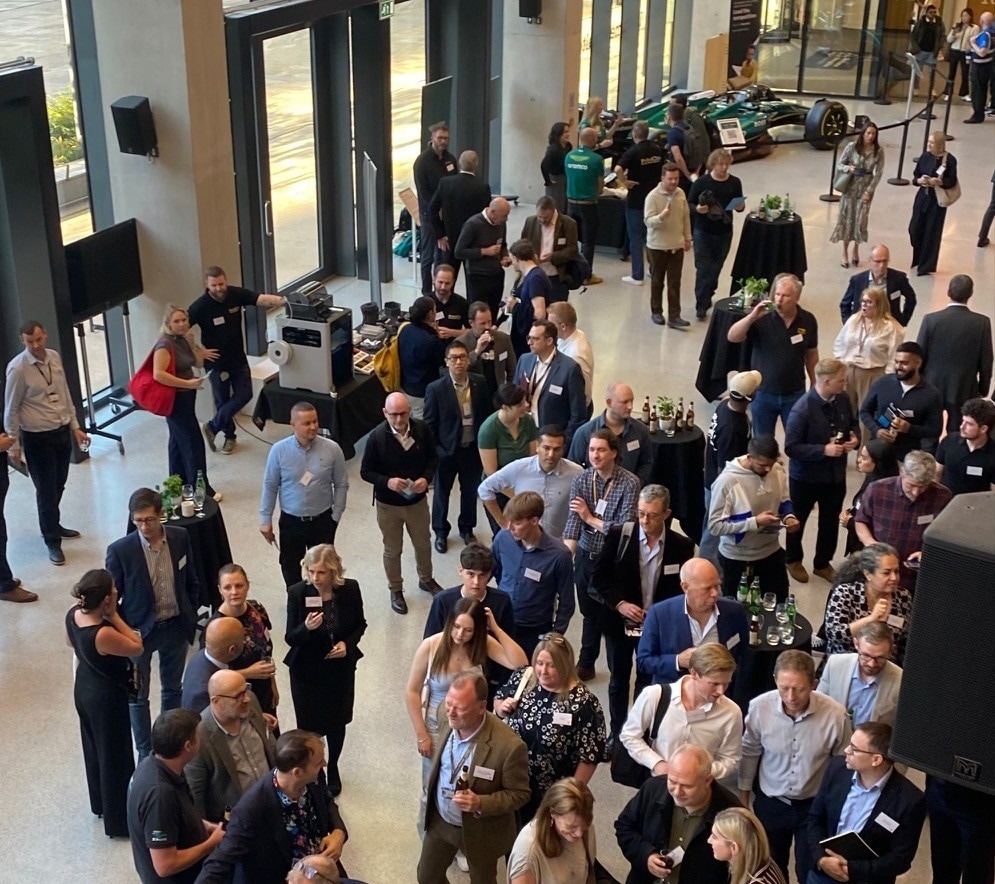Home to Print City, the Advanced Materials Manufacturing Innovation Centre (AMMIC), and the Fuel Cell Innovation Centre, Manchester Metropolitan University hosted Aston Martin, Siemens, and other industry leaders and researchers to discuss precision and performance in material science.
 Image Credit: Frances Briggs/AZoNetwork.com
Image Credit: Frances Briggs/AZoNetwork.com
On Thursday 25 September, Manchester Metropolitan University brought together industry leaders from Formula One, Siemens, The Rakem Group, and beyond to explore how research and industry intersect in the pursuit of precision and performance. The event presented the university's cutting-edge work in material science, from hydrogen systems and advanced coatings to metamaterials and digital manufacturing, showing how collaboration between industry professionals and academics can accelerate innovation.
A Foreword from Aston Martin's COO for Formula One
My journey into Formula One really started at this university. I learned very quickly about pragmatic engineering solutions, and how important it was to use people, as well as processes and tools, to bring to life some of the greatest resolutions to the engineering challenges we see on Planet Earth.
Ben Fitzgerald, Chief Operating Officer, Aston Martin Aramco Formula One
Ben Fitzgerald's reflections highlight how much universities and industry stand to gain from working side by side. Formula One brings the urgency and precision of real-world performance, while academic research provides the depth and rigor needed to push ideas further.
In Formula One, our singular challenge is developing performance. We focus on innovation and excellence to win. At the end of the day we just keep racing, all of the time we just keep racing.
Another key thing is translating engineering ideas to reality. Manufacturing system technology, our people, and processes, have enabled us to do this, taking eight week development times all the way down to three weeks.
Being here is really about how I see universities and industry helping each other moving forward, both in collaboration terms, in pipelines, and really in sharing technology in manufacturing and innovation.
Ben Fitzgerald, Chief Operating Officer, Aston Martin Aramco Formula One
See more about the event from Manchester Metropolitan University here!
Precision and Performance in Material Research
Alongside industry professionals from Siemens, MINI, and The Rakem Group, material scientists from Manchester Metropolitan introduced the current areas of focus in their research.
Electrocatalysis, Electrochemical Energy Storage and Conversion - Prof. Laurie King
Professor Laurie King is a materials chemist at MMU. Her research group focuses on all areas relating to electrocatalysis and electrochemical energy storage, with a particular focus on hydrogen.
We work on new materials and how we integrate them into technology's devices for the clean energy transition. When we think about clean energy, we often think of electrification. We can very clearly all picture replacing burning fossil fuels in terms of our transportation, or how we generate electricity. But we still want the materials available around us to remain the same. Whether that's chemicals we need to synthesize to make plastics to hold the medicines you might be taking, or any of the materials as part of those medicines.
In a nutshell, that's what we do. A lot of our work is centred around hydrogen: whether it be for chemical synthesis, transportation, or other, we are interested in making, designing, and optimizing the materials for hydrogen systems, such as electrolyzers.
Professor Laurie King, Materials Chemist, Dalton Building, Manchester Metropolitan University
A recent study by the group, published in EES Catalysis, presented the design and development of supported catalysts for the oxygen evolution reaction, helping to reduce iridium loading in low-cost, green hydrogen technology.
Proton exchange membrane water electrolyzers (PEM-ELs) are a technology that shows promise in the cost-effective production of green hydrogen. However, many catalysts lack the durability required to efficiently mediate the oxygen evolution reactions (OER) involved.
Professor King's research team used iridium-coated hollow titanium dioxide particles as oxygen evolution reaction catalysts to achieve higher Ir mass activities than leading commercial catalysts. They demonstrated exceptional durability for the supported iridium catalysts when compared against previously reported commercially available catalysts.
Advanced Functional Coatings - Dr. Justyna Kulczyk-Malecka
Dr. Justyna Kulczyk-Malecka is a surface engineer at MMU. Her group works on cross-disciplinary projects in the Surface Engineering Lab and Manchester Fuel Cell Innovation Centre.
Everything happens on the surface in material science. If you ask me, this is the most important part of any part in an engineering system! Surface engineering helps you control and tailor the properties of materials, without changing the intrinsic, or bulk properties.
My group focuses on coatings for hostile environment applications. I'm interested in all the environments that are destructive for materials, and I try to find a coating that will solve your problems that arise as a result of those environments. A harsh environment could be corrosive, could cause oxidation, and so on. We focus on the durability of materials and extending the life time of engineered parts. We are a pilot-plant production and have helped industry to do this.
Dr. Justyna Kulczyk-Malecka, Surface Engineer, Dalton Building, Manchester Metropolitan University
Published in Surface and Coatings Technology, her group's most recent research output demonstrates the effect of transition metal doping on the high-temperature and tribological properties of CrYN coatings.
Using magnetron sputtering to create the coatings, the study showed that tribomechanical stability was maintained at elevated temperatures when materials were protected by Me-CrYN coatings, with hardness values ranging from 8.8 to 15.3 GPa. Nb-doped coatings exhibited a reduction in friction from approximately 0.55 at room temperature to approximately 0.30 at 650 °C, while Ta-doped coatings showed stable values around 0.40 across all temperatures (<5 % variation).
In contrast, V-doped coatings showed an initial rise of approximately 115 %, but then decreased to about 0.10 at 550 °C and 0.12 at 650 °C. They found that adhesion strength was preserved after thermal exposure, supporting the potential of these coatings for high-temperature applications.
Download your PDF now!
Mechanical Metamaterials - Dr. Olly Duncan
Dr. Olly Duncan is a mechanical engineer at MMU. He co-leads a special interest group on mechanical metamaterials within the UK Metamaterials Network.
Metamaterials gain their properties from their structure, rather than their chemical or electrostatic bonds that we might be used to. They can have a vast array of different properties, which then allow us to target new opportunities.
There are two different ways we can do that. We can do that passively, by designing the sub structure which improves the strength or durability of materials, optimizing impact and so on. It can also be done actively, where we get some external energy source and use that to control the material. You can control how it deforms and its effective properties, or it can switch between. This can be particularly challenging when moving from lab to scale, and that is what I'm particularly interested in, translating the materials into scale and for commercial use. I'm interested in creating and designing efficiently.
Dr. Olly Duncan, Mechanical Engineer, Dalton Building, Manchester Metropolitan University
His most recent study, published in Advanced Science, focuses on the magnetic control of nonreversability and nonreciprocity in programmable movement.
Nonreciprocity is the deformation of a material that is not mirrored when a body is loaded equally from opposite sides. When combined with non-reversible deformation, material research could meet the complicated mechanical problems in soft body dynamics. Dr. Duncan's group presented a magneto-mechanical metamaterial-based structure that simultaneously exhibited both phenomena using elastic and magnetically induced nonlinearities.
They showed how their system could undergo a transition in its static mechanical properties, like stiffness, which led to distinct changes in energy absorption. They also found that with this asymmetric distribution of magnetic inclusions, the entire structure could exhibit an efficient locomotion mechanism suitable for applications in robotics.
Digital Manufacturing Processes - Prof. Russ Harris
Holding a chair position in manufacturing research, Professor Russ Harris has recently started a new research group at MMU. His group focuses on the transformative effects of manufacturing processes.
My research group concerns new manufacturing processes. Our work is discovery led but challenge driven, and is often quite fundamental to advanced manufacturing. We work on new machinery and apparatus to make new things, typically under computer control.
We have a unique capability here at MMU, of the possibility of doing that with complex shapes. We works with a large amount of different devices and technology here to do this work.
Professor Russ Harris, Professor of Manufacturing Research, Dalton Building, Manchester Metropolitan University
One such study from Professor Harris' group, published in IEE Robotics and Automation Letters, draws on natural growth and movement. The research team manufactured vine robots with magnetic skin for use in surgical applications.
They proposed an orthogonal magnetization strategy that successfully preserved a net positive magnetization and used this capability to construct a vine robot, eight millimeters in diameter, made from a polyethylene substrate coated with a silicon layer with magnetic microparticles.
The robot was able to steer and navigate complicated environments, avoiding obstacles without shearing. This was possible by simultaneously controlling the magnetic field and pressure. The vine robot successfully performed selective navigation of multiple bifurcations within a bronchial tree phantom, and could be used in the future in complicated heart surgeries, according to Professor Harris.

Image Credit: Frances Briggs/AZoNetwork.com
The Future of Materials Science
As Thursday's talk made clear, the future of materials science is in this balance between ambition and application. From hydrogen systems and protective coatings to programmable metamaterials and digitally manufactured robotics, the research at Manchester Metropolitan is already answering these questions.
The academics and industry professionals present at the event made clear that what remains constant is the need for shared expertise; for engineers, scientists, and manufacturers to work side by side to turn promising concepts into practical realities.